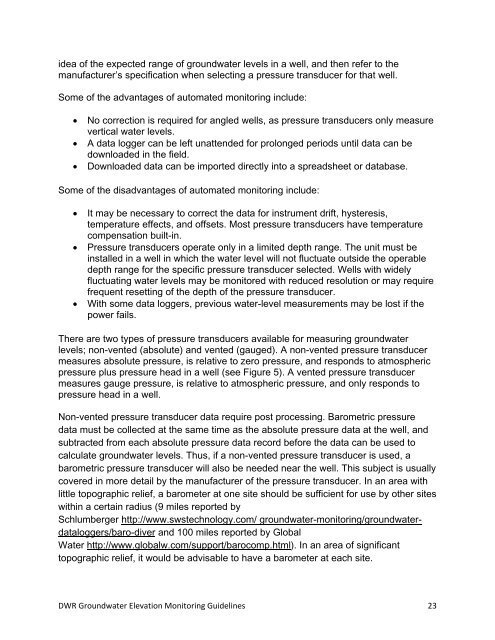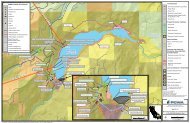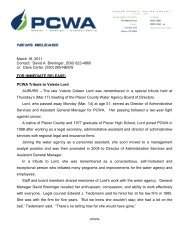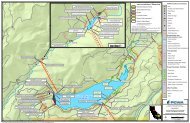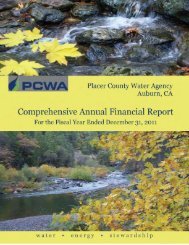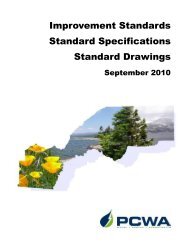Martis Valley Groundwater Management Plan - Placer County Water ...
Martis Valley Groundwater Management Plan - Placer County Water ...
Martis Valley Groundwater Management Plan - Placer County Water ...
You also want an ePaper? Increase the reach of your titles
YUMPU automatically turns print PDFs into web optimized ePapers that Google loves.
idea of the expected range of groundwater levels in a well, and then refer to the<br />
manufacturer’s specification when selecting a pressure transducer for that well.<br />
Some of the advantages of automated monitoring include:<br />
• No correction is required for angled wells, as pressure transducers only measure<br />
vertical water levels.<br />
• A data logger can be left unattended for prolonged periods until data can be<br />
downloaded in the field.<br />
• Downloaded data can be imported directly into a spreadsheet or database.<br />
Some of the disadvantages of automated monitoring include:<br />
• It may be necessary to correct the data for instrument drift, hysteresis,<br />
temperature effects, and offsets. Most pressure transducers have temperature<br />
compensation built-in.<br />
• Pressure transducers operate only in a limited depth range. The unit must be<br />
installed in a well in which the water level will not fluctuate outside the operable<br />
depth range for the specific pressure transducer selected. Wells with widely<br />
fluctuating water levels may be monitored with reduced resolution or may require<br />
frequent resetting of the depth of the pressure transducer.<br />
• With some data loggers, previous water-level measurements may be lost if the<br />
power fails.<br />
There are two types of pressure transducers available for measuring groundwater<br />
levels; non-vented (absolute) and vented (gauged). A non-vented pressure transducer<br />
measures absolute pressure, is relative to zero pressure, and responds to atmospheric<br />
pressure plus pressure head in a well (see Figure 5). A vented pressure transducer<br />
measures gauge pressure, is relative to atmospheric pressure, and only responds to<br />
pressure head in a well.<br />
Non-vented pressure transducer data require post processing. Barometric pressure<br />
data must be collected at the same time as the absolute pressure data at the well, and<br />
subtracted from each absolute pressure data record before the data can be used to<br />
calculate groundwater levels. Thus, if a non-vented pressure transducer is used, a<br />
barometric pressure transducer will also be needed near the well. This subject is usually<br />
covered in more detail by the manufacturer of the pressure transducer. In an area with<br />
little topographic relief, a barometer at one site should be sufficient for use by other sites<br />
within a certain radius (9 miles reported by<br />
Schlumberger http://www.swstechnology.com/ groundwater-monitoring/groundwaterdataloggers/baro-diver<br />
and 100 miles reported by Global<br />
<strong>Water</strong> http://www.globalw.com/support/barocomp.html). In an area of significant<br />
topographic relief, it would be advisable to have a barometer at each site.<br />
DWR <strong>Groundwater</strong> Elevation Monitoring Guidelines 23


